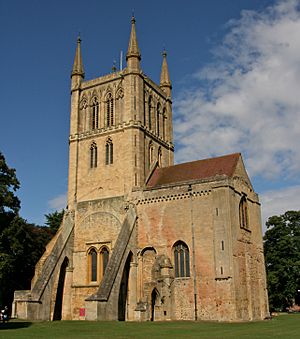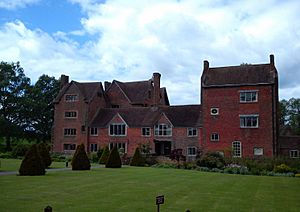Adam de Harvington facts for kids
Adam de Harvington, also known as Adam de Herwynton (born around 1270, died around 1345), was an important government official and judge in the 1300s. He had a very successful career in both England and Ireland. He held high positions like Chief Baron of the Irish Exchequer and Lord Treasurer of Ireland. He was also Chancellor of the Exchequer in England. Adam became quite wealthy during his time in these roles.
Contents
Adam's Family and Hometown
Adam got his name from his birthplace, Harvington, in Worcestershire, England. His father was William de Harvington. Adam likely lived at Harvington Hall, which he rented from the Earl of Warwick. He is thought to have passed away there.
Adam had a strong connection to Pershore Abbey throughout his life. William de Harvington, who was the Abbot of Pershore from 1307 to 1340, was Adam's cousin. Adam was later described as William's heir.
Adam's Early Career and Supporters
Adam's journey to high positions began with the help of powerful people. His main supporter was Guy de Beauchamp, 10th Earl of Warwick, who passed away in 1315. It was probably Earl Warwick who helped Adam become Deputy Chamberlain of the Exchequer (a government department that handled money) in 1298. Warwick also convinced King Edward I to give Adam the manor of Talton in Worcestershire in 1303.
Adam was very loyal to Earl Warwick. He helped manage Warwick's will after the Earl died in 1315. Adam even mentioned in his own will how much he owed to the Earl.
Adam also worked for the Diocese of Worcester. In the 1320s, he often acted as the Vicar-general for the Diocese, helping to manage its affairs. He also sometimes worked for the powerful Mortimer family, helping them with legal matters.
Adam's Time in Ireland
After Earl Warwick's death, Adam found a new supporter in Thomas, 2nd Earl of Lancaster, who was King Edward I's nephew. Adam became Keeper of the Rolls of the Bench at Westminster in 1314. He also served as a Commissioner for legal investigations between 1314 and 1322.
Even after Earl Lancaster faced serious charges and was executed in 1322, Adam's career continued to thrive. He was seen as a valuable and hardworking official for the King. In 1324, he was sent to Ireland to serve as Chief Baron. He also briefly held the positions of Chancellor of the Exchequer of Ireland and Lord High Treasurer of Ireland in 1325–1326. This happened after another official, Walter de Islip, faced problems with his accounts. Adam was one of the officials in charge of looking after Walter's property during this time. Adam returned to England in 1327 to become Chancellor of the Exchequer.
Adam's Later Years
Adam retired to his home county of Worcestershire in 1330. His main properties there were Harvington Hall and Frankley. In his final years, he gave many generous gifts to Pershore Abbey.
Adam was still alive in 1342, as he made a land transfer that year. He passed away by 1346. His cousin, Abbot Walter, who died in 1340, left Adam two manors in Worcestershire. In his will, Adam left money to Pershore Abbey to build a special chapel where prayers would be said for his soul and for the soul of his first supporter, Guy, Earl of Warwick. He also gave gifts to Halesowen Abbey in Shropshire.





